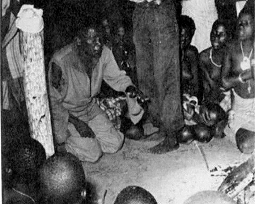Stayt's (1931 :118) account of this show agrees with what I saw on a number of occasions. The master takes a stick about a foot long and fixes it into the ground near the fire. Each novice must approach the fire on her knees and pick up the stick with her teeth. In some cases she may be told to replace it, again with her teeth; but in others, the master may do this himself and call the next novice to pick it up. When the master at Thengwe demonstrated how it should be done, he put on a great act to suggest that it was very difficult and that the fire was almost unbearably hot, which it was not! |
|
A tree fern, whose bark has been removed, is rammed in the ground and adorned with a 'turban'. The master of initiation is leading a song related to the piece of stick which has been placed in the fire on the right of the photograph. |
| Some say that this is an essential rite (ngoma), and that it should be accompanied by domba, in which the words of the first line of Domba Song No. 9 occur. But at Thengwe and Makonde, at least, it is accompanied by Song No. 9, which is described as luimbo lwa Lesson The most common explanation is that a woman may not make love to a man during menstruation. Just as a vulture who has dropped its prey in a fire can never retrieve it, so a man daring to have intercourse with a menstruating woman will become sick and die. The stick is, of course, a phallic symbol, and the fire is associated with menstrual blood. Another explanation is that if a man makes a girl pregnant, he cannot avoid the consequences by withdrawing, and he must not allow his lover to have an abortion. |
|
To return, click 'Back' in the browser. |
